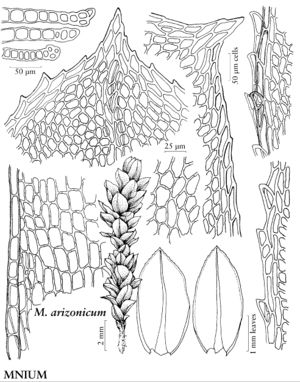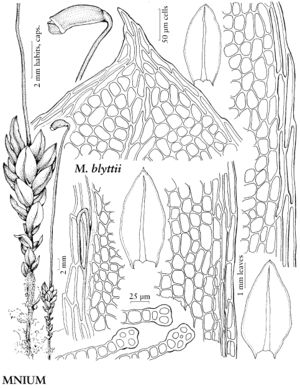Mnium
Sp. Musc. Frond., 188, plate 45. 1801.
| Taxon | Illustrator ⠉ | |
|---|---|---|
 | Mnium arizonicum | Patricia M. Eckel |
 | Mnium blyttii | Patricia M. Eckel |
 | Mnium lycopodioides | Patricia M. Eckel |
| ... further results | ||
Plants (0.5–) 2–4 (–8) cm, in open to compact tufts or mats. Stems red, reddish-brown, or brown, rarely yellowish-brown, erect, simple or branched distally, not dendroid; rhizoids brown, macronemata mainly proximal, micronemata absent. Leaves green to dark green, sometimes yellowish, often crisped and contorted, sometimes undulate, sometimes spirally twisted when dry, patent, erect-spreading, or spreading, usually ± flat when moist, elliptic, obovate, oblong-ovate, ovate, ovate-elliptic, ovate or elliptic-lanceolate, or obovate-spatulate, 1.5–6.5 mm, proximal leaves much smaller; base short to long-decurrent; margins plane, green, reddish-brown, or brown, 1-stratose or 2-stratose, sometimes multistratose with stereid band, toothed distally or to below mid leaf, teeth usually paired and often sharp, sometimes single, small, and blunt, rarely rounded or indistinct; apex acute, obtuse, rarely rounded, or acuminate, apiculate or sometimes cuspidate, cusp often toothed; costa percurrent or excurrent, rarely subpercurrent or ending well before apex, distal abaxial surface smooth or toothed; medial laminal cells usually elongate or ± isodiametric, sometimes oblong, (10–) 17–50 µm, sometimes in diagonal or longitudinal rows, collenchymatous or not, walls usually not pitted (pitted in M. arizonicum); marginal cells differentiated, linear, short-linear, or rhomboidal, in 1–4 (–5) rows. Specialized asexual reproduction absent. Sexual condition synoicous or dioicous. Seta single, rarely double or triple, usually yellowish and becoming red from base with age, 1–5 cm, straight or flexuose. Capsule horizontal to pendent, yellow, yellow-brown, or brown, oblong-cylindric, 2–7 mm; operculum conic-mammillate or conic-rostrate; exostome brown, greenish yellow, yellowish-brown, reddish-brown, or purplish; endostome yellowish or brown. Spores 15–40 µm.
Distribution
North America, Mexico, Central America (Guatemala), South America, Eurasia, Africa, circumboreal
Discussion
Species 19 (9 in the flora).
In most cases, Mnium is distinguished from other genera of Mniaceae by the presence of paired teeth along the leaf margins. However, M. blyttii and M. stellare usually have single, indistinct marginal teeth, and leaves may lack teeth altogether. Trachycystis flagellaris also has paired marginal teeth but is readily distinguished by mammillose laminal cells. Depauperate plants of M. arizonicum and M. thomsonii, but also, in a few cases, M. marginatum, have leaves with only a few single, small teeth. Although Mnium is characterized by a wide range in morphological variation related to environmental conditions, plant age, and sexuality (T. J. Koponen 1974), most vigorous collections with well-developed leaves should be readily identified.
Blue postmortal color (mnioindigon) is often used to separate Mnium blyttii and M. stellare from other species of Mnium. Although often observed in younger collections when leaves are soaked only in water, it is most readily observed in older specimens if plants are dipped sequentially in alcohol (70–90%), 2% KOH, and water.
Selected References
None.
Lower Taxa
Key
| 1 | Marginal cells in 1-2(-3) rows; margins 1-stratose, rarely 2-stratose in short sections; margins entire or weakly toothed distally, teeth single or rarely paired, small, blunt; blue postmortal color often present in laminal cells | > 2 |
| 1 | Marginal cells usually in more than 2 rows; margins 1- to multistratose, toothed often to below mid leaf, teeth usually paired, usually large and sharp, rarely nearly absent; blue postmortal color absent from laminal cells | > 3 |
| 2 | Leaves usually more than 2.5 mm; marginal cells linear; plants usually more than 2 cm. | Mnium blyttii |
| 2 | Leaves usually less than 2.5 mm; marginal cells short-linear or rhomboidal; plants usually less than 2 cm. | Mnium stellare |
| 3 | Laminal cell walls pitted; marginal cells short-linear or rhomboidal. | Mnium arizonicum |
| 3 | Laminal cell walls not pitted; marginal cells linear | > 4 |
| 4 | Leaves to 6 mm; costa ending well before apex or occasionally percurrent, distal abaxial surface strongly toothed, adaxial surface occasionally toothed; e North America. | Mnium hornum |
| 4 | Leaves usually to 4(-5) mm; costa percurrent or excurrent, abaxial surface toothed or smooth, adaxial surface smooth (rarely toothed in M. spinosum); mostly widespread | > 5 |
| 5 | Medial laminal cells (10-)14-22(-25) µm. | Mnium thomsonii |
| 5 | Medial laminal cells mostly more than 25 µm | > 6 |
| 6 | Leaves usually obovate; marginal teeth long, sharp, usually restricted to distal 1/2 of leaf; margins multistratose with stereid band; laminal cells not collenchymatous. | Mnium spinulosum |
| 6 | Leaves ovate-elliptic, elliptic, or oblong-ovate, rarely obovate; marginal teeth large or small, sharp or blunt, usually to below mid leaf; margins 2- or multistratose, stereid band usually absent (present in M. spinosum); laminal cells collenchymatous or not | > 7 |
| 7 | Laminal cells not or weakly collenchymatous; marginal teeth large, sharp; arctic or alpine. | Mnium spinosum |
| 7 | Laminal cells usually strongly collenchymatous; marginal teeth small to large, sharp or blunt; widespread | > 8 |
| 8 | Leaves narrowly elliptic, ovate-elliptic, or ovate-oblong; marginal teeth long, sharp, occasionally short and blunt; costae with distal abaxial surface toothed; sexual condition dioicous. | Mnium lycopodioides |
| 8 | Leaves usually ovate-elliptic; marginal teeth small to large, blunt or occasionally sharp; costae usually smooth, on well-developed leaves distal abaxial surface rarely with few blunt teeth; sexual condition synoicous or rarely dioicous. | Mnium marginatum |